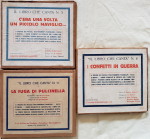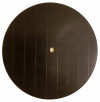Piccola Meraviglia & Libri Che Canta |
|
| Starting sometime around 1923, just as Columbia was winding down Little Wonder records and the Bubble Book series (which was moving into the hands of Victor), Columbia launched a childrenís book series in Italy, Libri Che Canta, which translates to "Books that Sing," the tagline for the Bubble Books. -The books donít have any date or copyright information and so dating has relied on advertisements and catalogues. -As far as I can tell, the series grew to include twelve volumes (see the Discography page for complete details about each volume and the records each contain). -Itís quite likely the books were sold in boxes (see left) Ė I have three Ė and itís possible the records in the books were in sleeves (see left) Ė I have several that came that way. The price of the books varied over time. -Prices started at 20 lire when the books were launched, rose for a time to 24 lire, and then settled at 20 lire over most of their lifetime - although the price dropped to 12 lire for a time in 1936 and 15 lire in 1938 before returning to 20 lire in 1939. Like Bubble Books, these were a series of books that tell a story, with three records bound inside. -Unlike the Bubble Books, though, which were created by the same writer, illustrator and performer team and told stories about a boy blowing bubbles in which characters arrived, each Libro Che Canta was created by a different team of writers, illustrators and performers and told unrelated stories. The records in the first nine volumes were single-sided with designs on the back. -The first volume was issue in two editions. -One edition, which I believe was the very first book created, was not as tall as the other books, with records that were only 5Ĺ inches, like Little Wonders. -The records in this edition used the actual Little Wonder label, were numbered 0257 through 0259, and had a grid etched on the back (see left). -It is possible that these records were part of (perhaps the end of?) the small series of Little Wonder records Columbia produced in Italy that used the Little Wonder label and had their own numbering system; these numbers are not included in the Italian Little Wonder catalogue, which intriguingly lists records up to 0256. -(See the Label page for examples of all the Piccola Meraviglia and Libro Che Canta labels discussed here.) The other edition of this first volume had features that were consistent with volumes two through nine: -The records were now 6-inches, had pink-and-maroon Piccola Meraviglia labels, were renumbered in a "BY" series, and had a stunning design etched on the back (see left). -Perhaps this edition reflects a decision by Columbia to stop producing an Italian series of Little Wonder records and start producing a series called Piccola Meraviglia (see below). The series grew in the same way the Bubble Book series did: -Columbia likely didnít know in the early days whether these books would be successful and how many they would create, and so early books contain series listings that only go up to that book (e.g., the ninth book has a listing that only includes books one through eight). At some time in the late 1920s, Columbia started producing Piccola Meraviglia records separate from Libri Che Canta -- the first catalogue I have that lists these records is from 1928. -These were priced at 7 lire when launched, 6 lire in 1930, 4 lire in 1936 (a larger price drop also reflected in a lower price for Libri Che Canta that year), and 5 lire from 1938 on (my 1937 catalogue does not give prices; see the Advertisements page for all of the advertisements and catalogues I have found that include these books and records). -These were double-sided and numbered in a "PM" series. -The earliest have the pink-and-maroon labels and later ones (and likely re-issues of earlier ones) have a maroon label. -And, as near as I can tell, these were sold in sleeves, some from Piccola Meraviglia and others from dealers (see examples at left). I believe that the tenth Libro Che Canta book dates from around this time: -My 1928 catalogue only includes books one through nine, while my 1930 catalogue includes book ten (I donít have a 1929 catalogue). -The records in these books were just like other Piccola Meraviglia records -- double-sided, used the maroon label, and were numbered in the PM series. -Volume ten records were early in the PM series (numbered 47, 85 and 86) and this volume did not tell a story; instead, PM 85 and PM 86 repeated each of the three songs from volume one and one song from volume three, and PM 47 is a new recording that featured imitations of animals (which was also reissued as PM 178 -- until I find a complete volume 10, I can't be completely certain that PM 47 and not PM 178 is the record that was originally included). Both volume eleven and twelve were issued at the very end of the Piccola Meraviglia series (eleven included PM 190-192; twelve included PM 195-197). -Volume eleven and its records make their first appearance in my 1938 catalogue (my 1937 catalogue does not have a listing for Libri Che Canta, so that date is also possible). -A 1939 catalogue shows PM records through 195, the first record in volume twelve. Further confirmation of the dating of books ten and eleven comes from the listings of their single records in the catalogues from
1937 onwards.
The records featured all kinds of music appealing to the general public (catalogues categorized the selections as songs,
operettas, hymns, dance music, solos for violin and clarinet, and "for the small world"). -The records included top Italian
performers of the age, like Paolo Bernard, a singer, actor and comedian,
and Crivel and Ines Talamo, artists at the top of the Columbia list in the early 1930s (according to
Massimo Baldino). -And just like Little Wonders, there are some that would not be politically
correct today: -For example, PM188, "Faccetta Nera"
(Little Black Face) is a marching song, popular in Fascist Italy about the Second Italo-Ethiopian War, telling the tale of a beautiful Ethiopian slave
girl. -Other records include Micco Maccoís nursery rhymes (read by the writer and translator Carmen Tornaghi), stories in verse
that include Fascist elements. It seems that Columbia produced only 200 or so Piccola Meraviglia records; the highest number found, and in any catalogue,
is PM 197, the last record in volume twelve of Libra Che Canta. -Like Little Wonders, Piccola Meraviglia records had
their biggest growth in their early years, with few releases (and likely less sales) toward the end. -Using catalogues
as a rough indicator of production, shows there were 20 new releases per year on average from 1928 to 1930, 15 new releases per year on average
from 1930 to 1936, and only 2-3 new per year on average from 1936 to 1940. |








